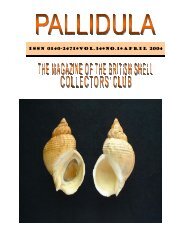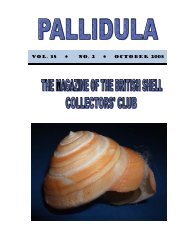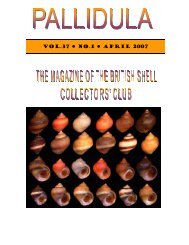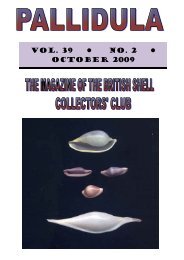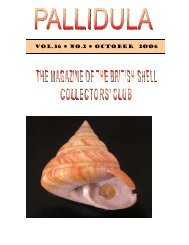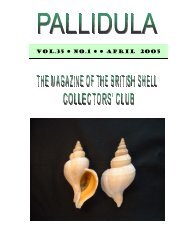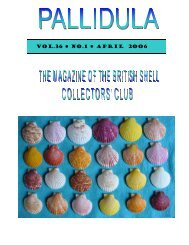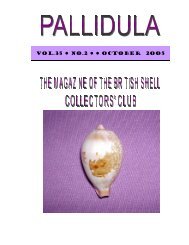October, 2004 - British Shell Collectors' Club
October, 2004 - British Shell Collectors' Club
October, 2004 - British Shell Collectors' Club
- No tags were found...
Create successful ePaper yourself
Turn your PDF publications into a flip-book with our unique Google optimized e-Paper software.
Page 12PALLIDULAThe Howletts’ <strong>Shell</strong> Weekend <strong>2004</strong>by Peter TopleyThe weekend of 19 th to 20 th June this year saw Derek and Daphne Howlett open their house in the small villageof Rockland St Mary once more for a “<strong>Shell</strong>ers’ Get-together”. For those of us who attended many thanks aredue to Derek and Daphne for their generous supply of food and drink, and arrangement of local accommodationfor those travelling from a distance, which helped the weekend go smoothly. <strong>Shell</strong>s that had been brought forsale or exchange were laid out in a large gazebo and in a summer house in the garden. The day was also anopportunity for both new and longstanding members to meet togetheraway from the more serious bustle of the <strong>Club</strong> Convention or <strong>Shell</strong>Show. Personally I valued the time to meet with other members andshare something of our thoughts and interests in the world of shells,where however much a beginner or an expert you may be in aparticular field, there is always something new to be discovered. Wewere also able to view Derek’s collection, which spans the whole worldof shells but in particular demonstrates his interest in land andfreshwater mollusca.On the Saturday afternoon those of us who had expressed an interestwere taken by Derek to the local Ted Ellis Nature reserve at WheatfenBroad. Former home of the well known East Anglian naturalist Ted Ellis until his death in 1986, the Ted Ellistrust was founded to preserve one of the few remaining areas of the once extensive Yare Valley swamp. This isa strange primitive area recognised as a Site of Special Scientific Interest and is one of the last tidal marshes ofthe Yare Valley. The reserve consists of open fen, reed beds, sallow carr and the small broads Wheatfen andDeep Waters. On arrival the party was split. The first group were given a guided walk around the reserve bywarden David Nobbs, partly in the hope of viewing the Swallowtail butterflies which can be seen if theconditions are right. Unfortunately this was not the case on the day which was overcast with some heavyshowers; but David made the walk enjoyable and interesting for those who attended.A second smaller group accompanied Derek along a flooded path which decided to amply demonstrate to usthe tidal nature of the fen! After donning life jackets we boarded a small flat-bottomed boat amongst the reeds,together with our collecting nets, dredge and containers. Many of the stems of the plants above water levelheld one or more actively crawling Amber Snails (Succinidae), brought out by the high tide and damp weather.Along the edge of the channels near Wheatfen broad we took samples of water plants, washing through ontrays to look for freshwater gastropods. Samples of bottom mud were also taken and sieved. Unfortunatelyamongst the shells found was a juvenile of the invasive alien Japanese freshwater clam Corbicula fluminea(Müller,1774) This was the first record within the reserve of this species, which is able completely to cover thesurface of the mud to the exclusion of native freshwater mussel species and is rapidly spreading through muchof the Broads system in Norfolk. We continued out into Rockland Broad, accompanied by the song of a nearbyCetti’s Warbler. Here we were able to carry out dredging along the sides of this quite shallow waterway andsamples of the larger freshwater mussels were taken including Unio pictorum (L.,1758), Anodonta cygnea(L.1758), A. anatina (L.,1758) and the local and rarer Compressed River Mussel Pseudanodonta complanata(Rossmassler, 1835) together with more (adult) C. fluminea. Fine sieving of mud samples also revealed thepresence of the small Pea Mussel Pisidium henslowanum (Sheppard, 1823), only identifiable later by the use ofa microscope and Derek’s expert eye!The remainder of the weekend consisted of specimen sorting, cleaning and identifying, as well as more time todiscuss such subjects as the intricacies of variation in cowries, that next shell show in Florida orrecommendations of economical storage systems for shells. Many thanks again to Derek and Daphne formaking this event such an enjoyable one for all involved.Species ListBithynia tentaculata (Linnaeus, 1758)Bithynia leachii (Sheppard, 1823)Potamopyrgus antipodarum (Gray,1840)Viviparus viviparus (Linnaeus, 1758)Lymnaea stagnalis (Linnaeus, 1758)Lymnaea auricularia (Linnaeus, 1758)Lymnaea peregra (Müller, 1774)Planorbis planorbis (Linnaeus, 1758)Anisus vortex (Linnaeus. 1758)Gyraulis albus (Müller, 1774)Acroloxus lacustris (Linnaeus, 1758)Anodonta anatina (Linnaeus, 1758)Anodonta cygnea (Linnaeus. 1758)Pseudanodonta complanata (Rossmassler, 1835)Unio pictorum (Linnaeus. 1758)Corbicula fluminea (Müller, 1774)Sphaerium corneum (Linnaeus, 1758)Musculum corneum (Linnaeus, 1758)Pisidium henslowanum (Sheppard, 1823)



